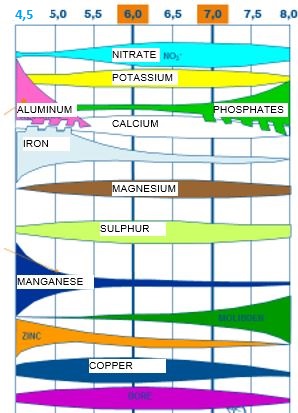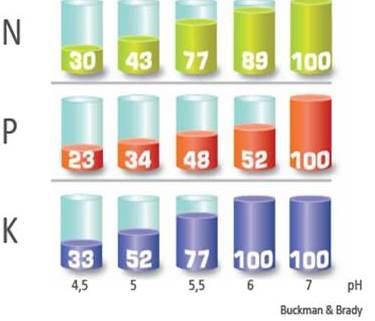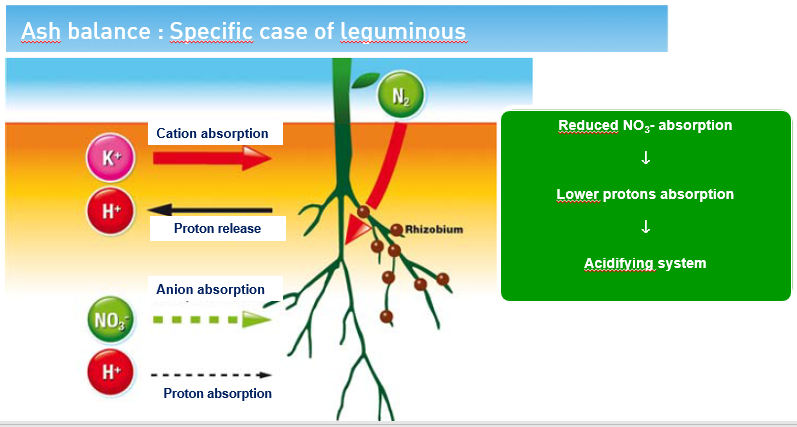If in the previous article we discussed about the soil structure (granular structure) and identified the mechanism through which a compact soil structure (“angular” aggregates) can be turned into a granular structure (of various sizes, but rounded in shape), in this article we will talk about the pH of the soil or, to be more specific, about how a soil with an acid pH, toxic for the plants, can be turned into a soil with a pH reaching neutral values, optimum for the plants, within a short period of time. And we will answer all farmers’ questions we have received so far.
However, firstly, in support of technology-oriented farmers, we make the following remarks:
Troug’s diagram highlights the importance of a neutral pH:

Chemical enhancement of the soil. Evolution of elements depending on the pH
Truog’s Diagram
The adjoining diagram shows that the elements beneficial to the plants are best assimilated in the case of a pH ranging between 6.8 and 7.2.
Each element (whether a nutrient or a toxic element) has an optimum range of soil pH.
Examples:
- Aluminum and manganese toxicity manifests at pH levels < 5.5.
- Heavy metals (Cd, Ni, Pb, etc.) are absorbed by the plants at pH levels < 5.2.
- In the case of a pH of 5.2, the Nitrogen availability reaches 43%, that of Phosphorus reaches 34%, whereas the Potassium availability is of 52%
In other words, aluminum and manganese toxicity in an acidic soil manifests through chlorosis (total or partial yellowing of the green parts of the plants), nanism (insufficient growth in height) or even the absence of the plants (Sade et al., 2016).
Moreover, Buckman & Brady illustrate the fertilizer loss amount depending on the pH of the soil:

For a better understanding of the graph, for a soil pH of 5, we pay for 100 kg active substance Nitrogen, which we introduce into the soil, but our plants (be it corn, soy, sunflower, cereals, rape, potato, etc.) only absorb 43 kg- the rest is either blocked, volatizes, or is carried away by the underground water.
Things are even worse for Phosphorus. For a pH of 5, out of 100 kg of active substance, the plants only use 34 kg, the rest being converted into forms that the plants cannot assimilate. Once again, a waste of money.
Is TerraCalco® beneficial for soy, peas and leguminous plants? YES, it is actually mandatory. Here is why:

In other words, in the atmospheric nitrogen fixation process, leguminous plants release hydrogen ions (H+ ions that acidify the soil). To be more specific, nitrogen fixation is a natural soil acidification factor (Kochia et al., 2004; Gupta et al., 2013; Bose et al., 2015).
The solution to quickly raise soil pH?
TerraCalco®. In corn and sunflower crops, in addition to the structuring of the soil (thus maximizing the exploration towards the radicular system of a larger soil volume), TerraCalco® also facilitates the optimum nutrition of the plants, by unblocking nutrients. Thus, the differences between the plots where we applied and those where we didn’t apply TerraCalco will be quite important, in terms of size and color, thus leading to an enhanced use of nutrients:
WITHOUT TERRACALCO® 95 WITH TERRACALCO® 95

Quite often, farmers ask us: can I use TerraCalco for alfalfa? What about potatoes? Corn? And soy?
The answer is simple: YES. TerraCalco® is applied directly onto the furrow or the stubble, before the seeding (and before the soil is processed for incorporation purposes), for the following crops:
|
Item no. |
Crop |
Optimum application period |
|
1 |
Corn |
November, December, January, February, March, April |
|
2 |
Sunflower |
November, December, January, February, March, April |
|
3 |
Beet |
November, December, January, February, March, April |
|
4 |
Leguminous plants (soy, peas, etc.) |
November, December, January, February, March, April |
|
5 |
Cereals (wheat, triticale, barley, oat, lentil, etc.) |
June, July, August, September, October |
|
6 |
Rape |
July, August, September |
|
7 |
Annual legumes |
November, December, January, February, March, April |
|
8 |
Biannual legumes |
September, October, November, December, January, March, April |
|
9 |
Perennial legumes |
September, October, November, December, January, March, April |
|
10 |
Alfalfa (clover etc.) |
September, October, November, December, January, February, March, April |
|
11 |
Fruit trees |
September, October, November, December, January, February, March, April |
|
12 |
Vine |
October, November, December, January, February, March, April |
|
13 |
Potato |
September, October, November, December, January, February, March, April |
|
14 |
Pasture lands and meadows |
September, October, November, December, January, February, March, April |
|
15 |
Fruit shrubs (raspberry, blackberry, goji, etc.) |
September, October, November, December, January, February, March, April |
|
16 |
Trees (Paulownia, etc.) |
September, October, November, December, January, February, March, April |
|
17 |
Turf |
September, October, November, December, January, February, March, April |
After understanding the benefits, the next question invariably is:
Why TerraCalco® and not another product?
For a number of reasons: firstly, the active substance content (we are talking about the active substance, not about carbonate) is of 98%. It is the ideal product, i.e., hypothetically speaking, somewhat of a triple 33 % (clearly superior to any of the products available on the market).
Secondly:
- Highest neutralization capacity (PNA or API) – 185
- Highest pH/product 12.7
- Accessible price
- Immediate action (as of the first application month)
- Low dose/surface unit, between 0.3 – max. 2 to/ha
- The initial investment is recovered both through the full use of yearly applied chemical fertilizers, and through the release of the existing reserve blocked in the soil, as well as through the structuring of the soil (easier to process, lower fuel consumption, less destroyed parts and less time spent/work)
- Granular; it spreads easily even at 36 m.
- It is packaged in 600 kg or 1.2 to big bags, with inner liner and discharge hole
- The action mechanism is quite simple, different from the carbonates (which must "get rid" of the CO2 before it can act). TerraCalco reacts with water to form 2 hydroxyl molecules (OH-), which directly act on the hydrogen (H+ acidity indicator), with 2 resulting water molecules.
How, when, where, how much should we apply?
TERRACALCO® is applied before soil works (superficial, using the harvester, the disk, the milling cutter, etc. or basic operations– scarification, ploughing) and then incorporated. It may be spread using the MA or the 12-24 or 36 m fertilizer spreader (depending on the machine).
It is applied directly onto the tillage, the prepared land or onto the stubble, before the seeding.
The dosage differs depending on the agrochemical mapping. Between 300 kg/ha and a maximum of 2 to/ha. As a general rule, the application of one ton provides a pH increase by a maximum of 1.5 percentage points (however, for safety and professionalism reasons, we need a mapping that mandatorily includes a hydrolytic acidity value)
Contact us for further information.
